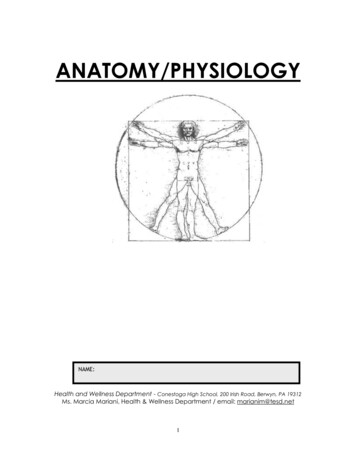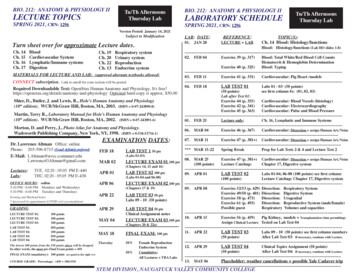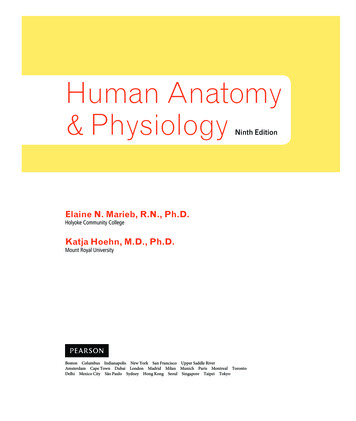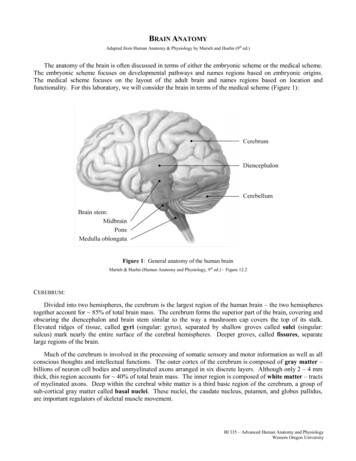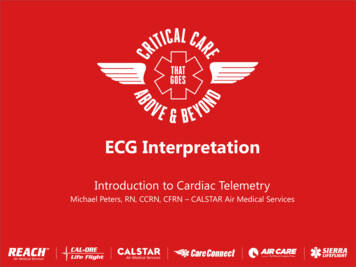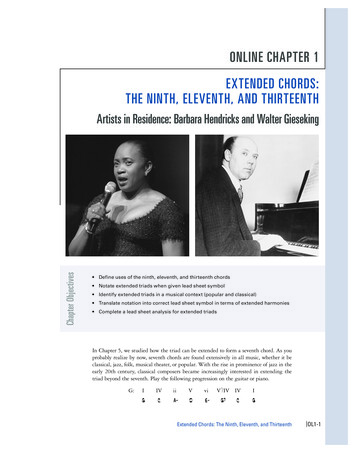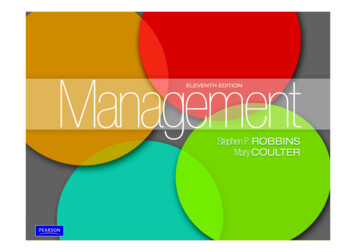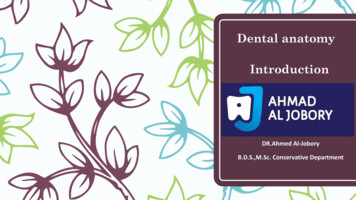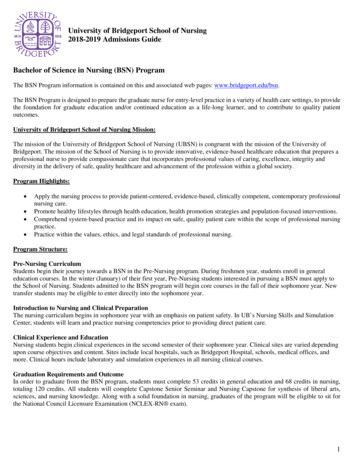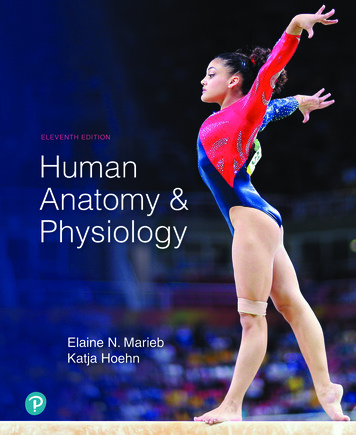
Transcription
ELEVENTH EDITIONHumanAnatomy &PhysiologyElaine N. MariebKatja Hoehn
Equipping You with 21st-Century Skillsto Succeed in A&P and Beyond The 11th Edition of Elaine Marieb and Katja Hoehn’s best-selling A&P text and media programmotivates and supports both novice learners and expert students, more than ever before. Eachcarefully-paced chapter guides you in advancing from mastering terminology to applying knowledgein clinical scenarios, to practicing the critical thinking and problem-solving skills that are required forentry to nursing, allied health, and exercise science programs.A01 MARI6300 11 SE FES.indd 207/11/17 6:30 PM
Identify “Big Picture” ConceptsBefore Exploring DetailsBefore you look up details and information within a chapter, read the ChapterOpening Roadmap, which visually groups and organizes “big picture” conceptsand shows how they are related. To focus your studying, review the numberedKey Concept Headings, Learning Outcomes, and summaries.UNIQUE! Chapter Roadmapsprovide a visual overview of the keyconcepts in the chapter and showhow they relate to each other. Eachkey concept “brick” in the roadmapcorresponds to a numbered sectionwithin the chapter.Each numbered section within thechapter begins with a Key ConceptHeading that helps you quickly graspthe “big idea” of the discussion thatfollows.UPDATED! Career ConnectionVideos feature a health careprofessional who describes howthe chapter content relates to theireveryday work. You can access allof the Career Connections videosthrough an open access web pageat https://goo.gl/88srfV.A01 MARI6300 11 SE FES.indd 3See p. 251Learning Outcomes are presented atthe beginning of each chapter sectionto give you a preview of essentialinformation to study.07/11/17 6:30 PM
Pace Yourself:Learn & Review the BasicsEXPANDED! Summary Tables present key information and serve as “one-stop shopping”study tools. 13 new Summary Tables have been added to this edition.See p. 162NEW! Text Recall icons guide you toreview specific pages where a concept wasfirst introduced.See p. 163NEW! Building Vocabulary Coaching Activities in Mastering A&P are a fun way to learn word rootsand A&P terminology while building and practicing important language skills.A02 MARI6300 11 SE FM.indd 107/11/17 6:27 PM
Study the Figuresas You Read the TextAnatomy and Physiology is a visual science. To succeed, you need to practice and develop visualliteracy skills for understanding and interpreting information. To help you achieve this goal, the textand associated figures are tightly integrated so that you never have to flip pages back and forth toconnect visuals with words.NEW Focus Figures are as follows:EXPANDED! 6 new Focus Figures (fora total of 26) walk you through complexprocesses using exceptionally clear, easyto-follow illustrations with integrated textexplanations.3.1 The Plasma Membrane, pp. 64–6511.4 Postsynaptic Potentials and Their Summation, pp. 418–41916.2 Stress and the Adrenal Gland, pp. 628–62918.2 The Cardiac Cycle, pp. 694–69521.1 An Example of a Primary Immune Response, pp. 808–80928.2 Fetal and Newborn Circulation, pp. 1108–1109See pp.808–809NEW! Focus Figure“Mini-Animation”Coaching Activitiesbring the 6 new FocusFigures to life usingshort video segments.Blue text represents the voice of an A&Pinstructor, highlighting important points toremember.EXPANDED! 31 unique In-LineFigures are strategically placed withinthe text to visually reinforce the textdiscussion.See p. 796A02 MARI6300 11 SE FM.indd 207/11/17 6:27 PM
Apply Your Knowledge to a Range &Variety of QuestionsAs you build your knowledge and confidence in A&P, practice responding to the more challengingquestions—you are likely to encounter similar questions on a test or licensing exam. Your extra effortwill pay off at exam time!NEW! A greater variety and rangeof self-assessment questionshave been added to the Check YourUnderstanding sections withineach chapter and include Apply,Predict, What If?, Draw, and MakeConnections. Dozens of new visualquestions ask you to label structuresor interpret visual information.See p. 400NEW! “Draw” questions ask you tocreate visuals that reinforce importantconcepts by drawing a structure, annotatinga figure, or creating a summary table.NEW! All of the End-of-Chapter Reviewquestions are now organized into 3 levelsof difficulty based on Bloom’s Taxonomycategories:Level 1: Remember/UnderstandLevel 2: Apply/AnalyzeLevel 3: Evaluate/SynthesizeSee p. 824 and Answers AppendixA02 MARI6300 11 SE FM.indd 307/11/17 6:27 PM
Prepare for Your Future Career &Practice Solving Real-World ProblemsThe authors of this text, Elaine Marieb and Katja Hoehn, share insights from their own clinical experience tohelp you prepare for your future career in health care. All clinical examples and applications are signaled withan easy-to-find “Clinical” label.UPDATED! Homeostatic Imbalance discussionsalert you to the consequences of body systemsnot functioning optimally. Relevant photos havebeen added to selected discussions for visualreinforcement.See p. 161UPDATED! Clinical Case Studies are provided at theend of Chapters 5–29 and challenge you to apply yourknowledge to realistic clinical scenarios.NEW! Each Clinical Case Study includes “NCLEXStyle” questions for practice with the kindsof challenge questions that you will eventuallyencounter on a licensing exam. Practice answeringthese questions on your own or in collaborationwith classmates. Your instructor can also assign newNCLEX-Style questions in Mastering A&P ,along with Homeostatic Imbalance questions, ClinicalCase Study Coaching Activities, and Nurses NeedPhysiology Case Studies.See p. 641A02 MARI6300 11 SE FM.indd 407/11/17 6:27 PM
Access the Complete Textbook Onlineor Offline Using the Pearson eTextYou can read your textbook without having to add weight to your bookbag!The Pearson eTextmobile app offersoffline access and canbe downloaded formost iOS and Androidphones and tabletsfrom the Apple App orGoogle Play stores.Powerful interactiveand customizationfunctions includeinstructor andstudent notetaking, highlighting,bookmarking, search,and links to glossaryterms. The Marieb/Hoehn eText alsoincludes dozens ofembedded videos andanimations that bringA&P concepts to life.A02 MARI6300 11 SE FM.indd 507/11/17 6:27 PM
Get Online Practice and Coachingwith Mastering A&P Mastering A&P provides tutorials and review questions that you can access before,during, and after class.EXPANDED! Interactive Physiology 2.0 CoachingActivities teach complex physiology processes usingexceptionally clear animations, interactive tutorials, games,and quizzes. IP2 features new graphics, quicker navigation,and a mobile-friendly design. New topics includeGeneration of an Action Potential and Cardiac Cycle. IP2and IP animations can be assigned from the MasteringA&P item library or accessed through the Study Area.NEW! PAL 3.1 Customizable Flashcardsallow you to create a personalized, mobilefriendly deck of flashcards and quizzes usingimages from Practice Anatomy Lab. Use thechecklist to select only those structures coveredin your course.Dynamic Study Modules are manageable, mobilefriendly sets of questions with extensive feedbackfor you to test, learn, and retest yourself on basicconcepts. NEW! Instructors can select or deselectspecific questions for assignments from more than3,000 questions, organized by chapter section.A02 MARI6300 11 SE FM.indd 607/11/17 6:27 PM
New for Instructors:Ready-to-Go Teaching ModulesNEW! Ready-to-Go Teaching Modules help instructors efficiently make use of the best teachingtools before, during, and after class. Accessed through the Instructor Resources area of Mastering A&P and prepared by expert A&P instructors, each module includes a variety of teaching ideas and ready-touse resources for teaching 10 challenging course topics.Learning Catalytics allows students to use theirsmartphone, tablet, or laptop to respond to questions inclass. Visit learningcatalytics.com to learn more.A02 MARI6300 11 SE FM.indd 707/11/17 6:27 PM
Mastering A&P Features and AccessMastering A&P offers thousands of tutorials, activities, and questions that can be assigned for homework andpractice. Highlights of new assignment options include: NEW! Building Vocabulary Coaching Activitiesgive you practice learning and using word roots in contextas you learn new A&P terms. NEW! Focus Figure “Mini-Animation” CoachingActivities bring the 6 new Focus Figures to life andinclude assessment questions. IMPROVED! Concept Map Coaching Activitiessupport the concept maps in the text without requiringstudents to submit their own concept map for grading. NEW! NCLEX-Style Questions give students practicewith the kinds of questions that will eventually appear ona licensing exam.The Mastering A&P Instructor Resources Area includes the following downloadable tools for instructors who adoptthe Eleventh Edition for their classes: NEW! Ready-to-Go Teaching Modules provide teaching tools for 10 challenging topics in A&P.Customizable PowerPoint lecture outlines include customizable images and provide a springboardfor lecture prep.All of the figures, photos, and tables from the text are available in JPEG and PowerPoint formats, inlabeled and unlabeled versions, and with customizable labels and leader lines.Test bank provides thousands of customizable questions across Bloom’s Taxonomy levels. Each question istagged to chapter learning outcomes that can also be tracked within Mastering A&P assessments. Available in Microsoft Word and TestGen formats.Animations and videos bring A&P concepts to life and include A&P Flix 3-D Animations.A comprehensive Instructor Guide to Text and Media, co-authored by Elaine Marieb and LauraSteele, includes a detailed teaching outline for each chapter, along with a wealth of activities, examples,and analogies that have been thoroughly class-tested with thousands of students.Mastering A&P AccessUpon textbook purchase, students and teachers are granted access to Mastering A&P with Pearson eText. High schoolteachers can obtain preview or adoption access to Mastering A&P in one of the following ways:Preview Access Teachers can request preview access online by visiting www.PearsonSchool.com/Access Request. SelectScience, choose Initial Access, and complete the form under Option 2. Preview Access information will besent to the teacher via e-mail.Adoption Access With the purchase of this program, a Pearson Adoption Access Card with Instructor Manual will bedelivered with your textbook purchase. (ISBN: 978-0-13-354087-1)Ask your sales representative for a Pearson Adoption Access Card with Instructor Manual.(ISBN: 978-0-13-354087-1)OR Visit PearsonSchool.com/Access Request, select Science, choose Initial Access, and complete the form underOption 3—MyLab/Mastering Class Adoption Access. Teacher and Student access information will be sent tothe teacher via e-mail.Students, ask your teacher for accessPearson reserves the right to change and/or update technology platforms, including possible edition updates to customers during theterm of access. This will allow Pearson to continue to deliver the most up-to-date content and technology to customers. Customer will benotified of any change prior to the beginning of the new school year.A02 MARI6300 11 SE FM.indd 808/11/17 9:54 AM
HumanAnatomy& PhysiologyELEVENTH EDITIONElaine N. Marieb, R.N., Ph.D.Holyoke Community CollegeKatja Hoehn, M.D., Ph.D.Mount Royal UniversityA02 MARI6300 11 SE FM.indd 107/11/17 6:27 PM
Editor-in-Chief: Serina BeauparlantSenior Courseware Portfolio Manager: Lauren HarpManaging Producer: Nancy TaborContent & Design Manager: Michele Mangelli, Mangelli Productions, LLCCourseware Director, Content Development: Barbara YienCourseware Specialist: Laura SouthworthCourseware Senior Analyst: Barbara PriceCourseware Editorial Assistant: Dapinder DosanjhRich Media Content Producer: Lauren ChenMastering Content Developer: Cheryl ChiProduction Supervisor: Karen GulliverCopyeditor: Anita HueftleProofreaders: Betsy Dietrich and Martha GhentCompositor: Cenveo Publisher ServicesArt Coordinator: Jean LakeInterior & Cover Designer: Hespenheide DesignIllustrators: Imagineering STA Media Services, Inc.Rights & Permissions Management: Ben FerriniRights & Permissions Project Manager: Cenveo Publisher Services, Matt PerryPhoto Researcher: Kristin PiljayManufacturing Buyer: Stacey WeinbergerDirector of Product Marketing: Allison RonaSenior Anatomy & Physiology Specialist: Derek PerrigoDirector of Field Marketing: Tim GalliganCover photo credit: Tim Clayton/Corbis/Getty ImagesCopyright 2019, 2016, 2013 Pearson Education, Inc. All Rights Reserved. Printed in the United States ofAmerica. This publication is protected by copyright, and permission should be obtained from the publisherprior to any prohibited reproduction, storage in a retrieval system, or transmission in any form or by any means,electronic, mechanical, photocopying, recording, or otherwise. For information regarding permissions, requestforms and the appropriate contacts within the Pearson Education Global Rights & Permissions department,please visit www.pearsoned.com/permissions/.Acknowledgments of third-party content appear on page C1, which constitutes an extension of thiscopyright page.PEARSON, ALWAYS LEARNING , MasteringA&P , Practice Anatomy Lab , PAL , InteractivePhysiology , and A&P Flix are exclusive trademarks in the U.S. and/or other countries owned by PearsonEducation, Inc., or its affiliates.Unless otherwise indicated herein, any third-party trademarks that may appear in this work are the propertyof their respective owners and any references to third-party trademarks, logos or other trade dress are fordemonstrative or descriptive purposes only. Such references are not intended to imply any sponsorship,endorsement, authorization, or promotion of Pearson’s products by the owners of such marks, or anyrelationship between the owner and Pearson Education, Inc. or its affiliates, authors, licensees or distributors.Slinky is a registered trademark of Poof-Slinky Inc.Ziploc is a registered trademark of S. C. Johnson & Son Inc.Velcro is a registered trademark of Velcro BVBA.FedEx is a registered trademark of FedEx Corporation.Viagra is a registered trademark of Pfizer Inc.OxyContin is a registered trademark of Purdue Pharma L.P.Ventolin is a registered trademark of Glaxo Group Limited.Drāno is a registered trademark of S. C. Johnson & Son Inc.Lego is a registered trademark of Lego Juris A/S.South Beach Diet is a registered trademark of SBD Enterprises LLC.Atkins Diet is a trademark of Atkins Nutritionals Inc.Weight Watchers is a registered trademark of Weight Watchers International, Inc.Etch a Sketch is a registered trademark of Spin Master Ltd.PowerPoint is a registered trademark of Microsoft Corporation.Microsoft is a registered trademark of Microsoft Corporation.TestGen is a registered trademark of Tamarack Software Inc.Library of Congress Cataloging-in-Publication DataNames: Marieb, Elaine Nicpon, author. Hoehn, Katja, author.Title: Human anatomy & physiology / Elaine N. Marieb, R.N., Ph.D., HolyokeCommunity College, Katja Hoehn, M.D., Ph.D., Mount Royal University.Other titles: Human anatomy and physiologyDescription: Eleventh edition. Hoboken, New Jersey : Pearson Education,Inc., [2019] Includes index.Identifiers: LCCN 2017044428 ISBN 9780134580999 (Student edition) ISBN0134580990 (Student edition)Subjects: LCSH: Human physiology. Human anatomy.Classification: LCC QP34.5 .M265 2018 DDC 612—dc23LC record available at .com/AdvancedA02 MARI6300 11 SE FM.indd 217ISBN-10: 0-13-476630-X (High School Binding)ISBN-13: 978-0-13-476630-0 (High School Binding)07/11/17 6:27 PM
About the AuthorsWe dedicate this work to our students bothpresent and past, who always inspire us to“push the envelope.”Elaine N. MariebAfter receiving her Ph.D. in zoology from the University ofMassachusetts at Amherst, Elaine N. Marieb joined the facultyof the Biological Science Division of Holyoke Community College. While teaching at Holyoke Community College, wheremany of her students were pursuing nursing degrees, she developed a desire to better understand the relationship between thescientific study of the human body and the clinical aspects ofthe nursing practice. To that end, while continuing to teach fulltime, Dr. Marieb pursued her nursing education, which culminated in a Master of Science degree with a clinical specializationin gerontology from the University of Massachusetts. It is thisexperience that has informed the development of the unique perspective and accessibility for which her publications are known.Dr. Marieb has given generously to provide opportunities for students to further their education. She funds the E.N.Marieb Science Research Awards at Mount Holyoke College,which promotes research by undergraduate science majors, andhas underwritten renovation of the biology labs in Clapp Laboratory at that college. Dr. Marieb also contributes to the Universityof Massachusetts at Amherst, where she provided funding forreconstruction and instrumentation of a cutting-edge cytologyresearch laboratory. Recognizing the severe national shortageof nursing faculty, she underwrites the Nursing Scholars of theFuture Grant Program at the university.In 2012 and 2017, Dr. Marieb gave generous philanthropicsupport to Florida Gulf Coast University as a long-term investment in education, research, and training for healthcare andhuman services professionals in the local community. In honorof her contributions, the university is now home to the ElaineNicpon Marieb College of Health and Human Services.Katja HoehnDr. Katja Hoehn is a professor in the Department of Biology atMount Royal University in Calgary, Canada. Dr. Hoehn’s firstlove is teaching. Her teaching excellence has been recognized byseveral awards during her 24 years at Mount Royal University.These include a PanCanadian Educational Technology FacultyAward (1999), a Teaching Excellence Award from the Students’Association of Mount Royal (2001), and the Mount Royal Distinguished Faculty Teaching Award (2004).Dr. Hoehn received her M.D. (with Distinction) from theUniversity of Saskatchewan, and her Ph.D. in Pharmacologyfrom Dalhousie University. In 1991, the Dalhousie MedicalResearch Foundation presented her with the Max Forman (Jr.)Prize for excellence in medical research. During her Ph.D. andpostdoctoral studies, she also pursued her passion for teachingby presenting guest lectures to first- and second-year medicalstudents at Dalhousie University and at the University of Calgary.Dr. Hoehn has been a contributor to several books, writtennumerous research papers in Neuroscience and Pharmacology,and has co-authored theprevious four editionsof this textbook. Formany years, she has alsoreviewed and authoredelectronic media thataccompaniesPearsonanatomy and physiologybooks.Following Dr. Marieb’s example, Dr. Hoehn provides financial support for students in the form of a scholarship that she established in 2006 for nursing students at Mount Royal University.Dr. Hoehn is also actively involved in the Human Anatomyand Physiology Society (HAPS) and is a member of theAmerican Association of Anatomists. When not teaching, shelikes to spend time outdoors with her husband and two sons.She also enjoys competing in long-course triathlons, and playing Irish flute down at the local pub.iiiA02 MARI6300 11 SE FM.indd 307/11/17 6:27 PM
PrefaceToday’s students have access to an enormous amount ofinformation about anatomy and physiology. As educators,our biggest challenge is to help students focus on masteringthe basic concepts of this field. Providing this firm foundationwill help students to become lifelong learners who can critically evaluate new information, connect that information to thefoundation they have already established, and apply it in a clinical setting. How can we help students build a strong foundationin anatomy and physiology? We believe that this new edition ofour textbook will help learners by building on the strengths ofprevious editions while using new and innovative ways to helpstudents visualize connections between various concepts.Unifying ThemesNew to the Eleventh EditionThree unifying themes that have helped to organize and set thetone of this textbook continue to be valid and are retained inthis edition. These themes are:New and augmented elements aim to help learners in the following ways.Interrelationships of body organ systems. This theme empha-To help students make connections between new and previously learned material. In order for students to master newComplementarity of structure and function. This themeconcepts, they must link these new concepts with concepts theyalready understand. In this edition, we help them do this by adding: Text recall icons ( ). These icons direct the student back tothe specific pages where a concept was first introduced. Make Connections questions. We’ve added more of thistype of question to the Check Your Understanding reviewquestions that follow each module within a chapter. Toanswer these questions, the student must employ conceptslearned previously (most often in previous chapters). New kinds of higher-level questions. Each chapter nowhas at least five higher-level questions that require studentsto think more deeply, pulling together strands from multipleconcepts. These questions are clearly identified as APPLY ,DRAW , PREDICT , MAKE CONNECTIONS , and WHAT IF? questions. New summary tables. Students have told us that they wantmore summary tables. In response, 13 new summary tables(two with illustrations) have been added in order to helpstudents see the big picture.encourages students to understand the structure of some bodypart (ranging from a molecule to an organ) in order to understand the function of that structure. For example, muscle cellscan produce movement because they are contractile cells.To enhance students’ visual literacy. Anatomy is and hasalways been taught principally through images. Increasingly,however, physiological data is also represented as images,whether it be molecular interactions or graphical descriptions ofsizes the fact that nearly all regulatory mechanisms have interactions with several organ systems. The respiratory system,for example, cannot carry out its role of gas exchange in thebody if there are problems with the cardiovascular system thatprevent the normal delivery of blood throughout the body. TheSystem Connections feature and Make Connections questionsthroughout the book help students connect new informationto old information and think of the body as a community ofdynamic parts instead of a number of independent units.Homeostasis. Homeostasis is the normal and most desirablecondition of the body. Its loss is always associated with pastor present pathology. This theme is not included to emphasizepathological conditions, but rather to illustrate what happensin the body “when things go wrong” and homeostasis is lost.Whenever students see a red balance beam symbol accompanied by an associated clinical topic, their understanding of howthe body works to stay in balance is reinforced.ivA02 MARI6300 11 SE FM.indd 407/11/17 6:27 PM
vPrefaceprocesses. Throughout their future health care careers, studentswill need to be able to understand and interpret information presented visually. In this edition, we help them do this by: Adding new Focus figures. Focus figures are illustrationsthat use a “big picture” layout and dramatic art to guide thestudent through difficult physiological processes in a stepby-step way. Our previous Focus figures have been a hitwith both students and instructors. In response to requestsfor additional Focus figures, we are pleased to present sixnew two-page features. Adding DRAW questions in each chapter. Students oftenthink that they understand an illustration simply by looking at it, but to truly comprehend an illustration and cementits concepts requires a more active learning approach. Forthis reason we now include at least one higher-level reviewquestion within each chapter that requires a student either todraw an illustration or to add to an existing diagram. Adding questions about illustrations. To help studentspractice their visual literacy skills, we have added 47 newCheck Your Understanding questions that include an illustration as part of the question. Some of these are as simpleas labeling exercises, but many require more advancedinterpretation. Updating art to improve its teaching effectiveness. Asalways, this is a major part of the revision. Today’s studentsare accustomed to seeing sophisticated photorealisticallyrendered images. However, many students are not adept atextracting, and thinking critically about, the relevant information contained in such illustrations. With this in mind wecontinue to refine and update our illustrations as students’needs change, improving their ability to teach importantconcepts. In many cases we have added blue “instructor’svoice” text within the figure to guide a student through it,replacing much of the more remote figure legend. In addition, new photos were painstakingly chosen and labeled toenhance the learning process. Adding new illustrations to existing tables and addingnew illustrated tables. Students find illustrated tables par-ticularly effective because they provide a visual cue thathelps them remember a topic. In this edition, we have addedillustrations to two tables and added two new illustratedtables. Adding in-line figures. These are small (less than a halfcolumn wide) illustrations or photos strategically locatedwithin the text that discuss the concept they illustrate.This edition now has 31 such in-line figures, most of themnewly added.To help students clinically apply what they have learned Updated Homeostatic Imbalance features. Many of theHomeostatic Imbalance features have been updated andrelevant photos have been added to some. All have beenreviewed for accuracy and relevancy. In addition, the updatedbook design makes these features stand out more clearly. Updated Clinical Case Studies in Chapters 5-29 withadded new NCLEX-STYLE questions. The end-of-chapterA02 MARI6300 11 SE FM.indd 5review questions, which are now organized into threelevels of difficulty based on Bloom’s Taxonomy categories,culminate in a clinical case study that allows students toapply some of the concepts they have learned to a clinicalscenario. These case studies have been extensively revisedand each case study has two questions that are similar instyle to those in the NCLEX exam. New clinically relevant photos. We have added or updateda number of photos that have clinical relevance (procedures,conditions, etc.) that will help students apply what they arereading to real-life situations and to their future careers.In this edition, certain chapters have received the bulkof our attention and have been more heavily revised. As youcan see in the Highlights of New Content (below), these areChapters 2–4, 9, and 27–29.As in the previous edition, we have taken painstaking careto ensure that almost all the text and the associated art are covered on the same two-page spread. Although this sounds like asimple goal, it actually takes a great deal of work and has notusually been achieved by other textbooks. We make this effortbecause it is invaluable to student learning to not have to flippages back and forth between art and text. Finally, you willnotice the appearance of new icons referencing MasteringA&P interspersed within the text. This guides students to go to therelevant on-line activities to supplement their learning.Other Highlights of New ContentChapter 1 The Human Body: An Orientation New Figure 1.1 illustrates complementarity of structureand function. Updated A Closer Look feature on types of medical imagingand added five new photos. New Homeostatic Imbalance features about hiatal herniasand about “wrong site surgery.”Chapter 2 Chemistry Comes Alive New Homeostatic Imbalance feature about patient’s pH pre-dicting outcome of CPR. New figures illustrate triglyceride structure (2.16); thedifference between saturated and unsaturated fatty acids(2.17); phospholipids (2.18); and protein functions (2.20). Revised Figures 2.6 (formation of ionic bonds) and 2.12(dissociation of salt in water) teach more effectively. New summary tables reinforce information about chemical bonds (Table 2.2) and about macromolecules and theirmonomers and polymers (Table 2.5).Chapter 3 Cells: The Living Units Added Focus Figure 3.1 about the plasma membrane, andreorganized accompanying text. Reorganized text about passive membrane transport forimproved clarity; updated and reorganized discussion ofautophagy and apoptosis. Updated information about Tay-Sachs disease.07/11/17 6:27 PM
viPreface New micrographs show micro- and intermediate filaments Revised Figure 8.4 (bursae and tendon sheaths).(Figure 3.20). Improved teaching effectiveness of Figures 3.5 (diffusion),3.17 (processing and distribution of newly synthesized proteins), and 3.30 (stages of transcription). New information about telomeres in cancer cells. New Homeostatic Imbalance feature about progeria. Updated A Closer Look about prostheses.Chapter 4 Tissue: The Living Fabric Chapter 9 Muscles and Muscle Tissue New “Background and Overview” section begins the dis- New images of cilia show the difference between transmis sion and scanning electron microscopy (Figure 4.2).New in-line figure illustrates apical and basal surfaces ofepithelial cells.Revised art for epithelial and connective tissue for clarity(Figures 4.4 and 4.11).New Figure 4.5 shows how exocrine and endocrine glandsdiffer, and new Figure 4.10 gives an overview of the classification of connective tissue.Updated A Closer Look feature abou
Human Anatomy & Physiology ELEVENTH EDITION. The 11th Edition of Elaine Marieb and Katja Hoehn’s best-selling A&P text and media program motivates and supports both novice learners and expert students, more than ever before. Each

